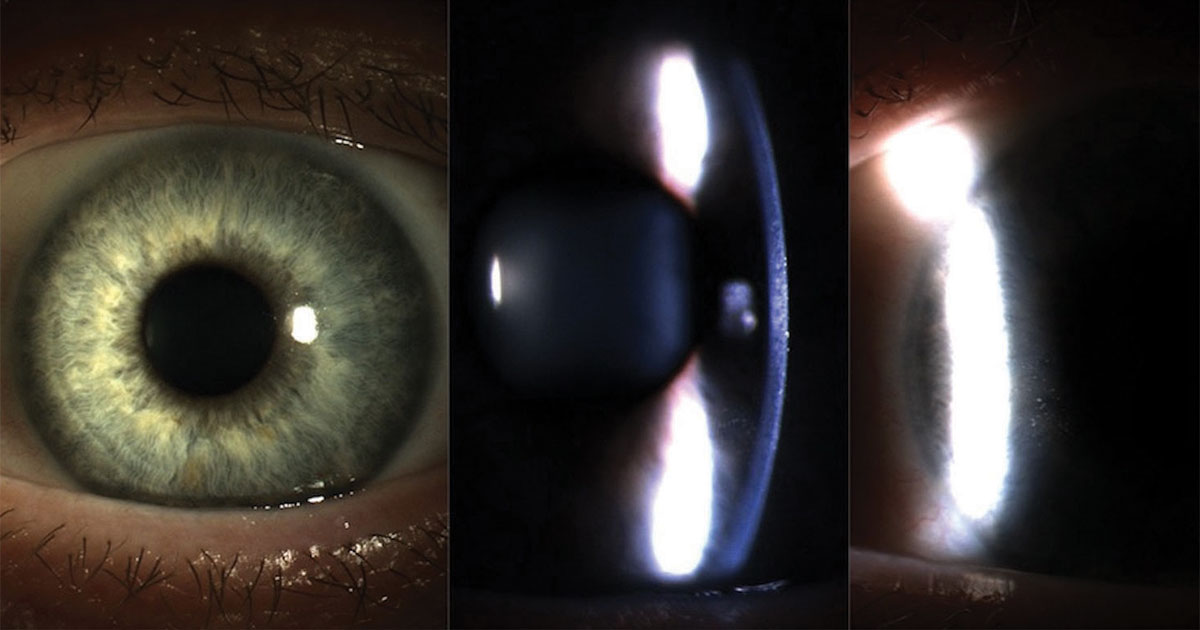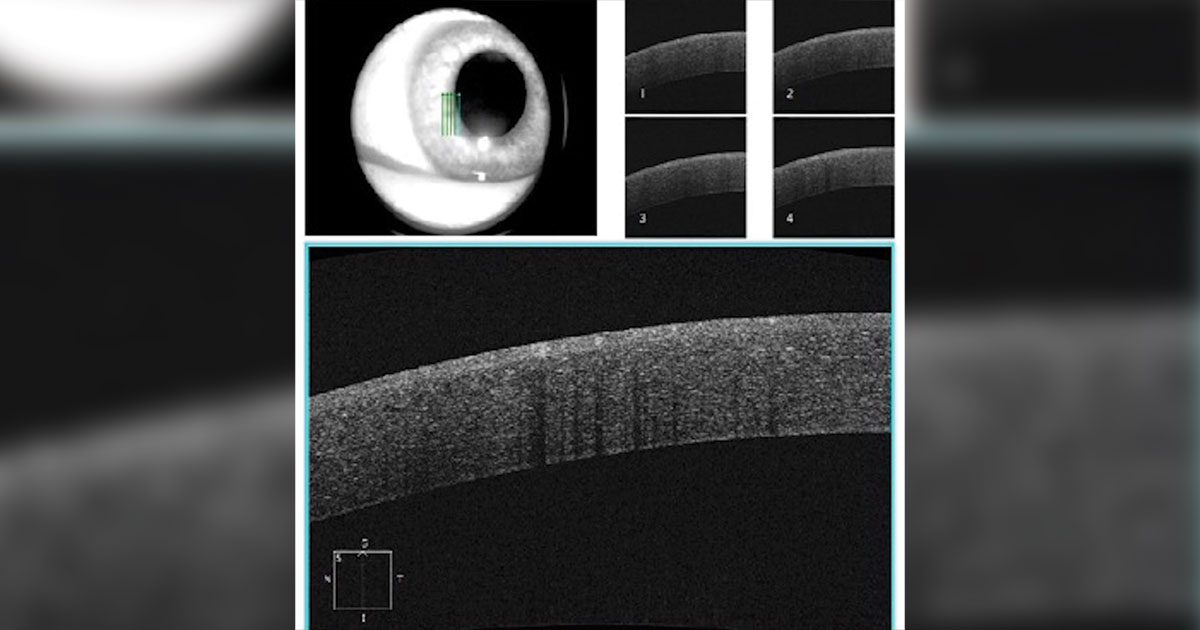Middle-aged woman presents with 2 weeks of blurry vision
A 45-year-old woman with a medical history of breast cancer status post mastectomy presented to Lahey Eye Clinic due to 2 weeks of blurry vision, described as a “haze over her eyes.”


Her symptoms followed an episode of severe eye pain upon opening her eyes. Additionally, she complained of photosensitivity but denied any flashes, new floaters, metamorphopsia, field of vision loss, eye redness or discharge. She had no significant ocular history, including refractive errors, eye trauma or surgeries.
Examination
The patient’s best uncorrected distance visual acuity was 20/60 in the right eye and 20/70 in the left eye. It improved with pinhole to 20/30 and 20/50 in the right eye and left eye, respectively. Pupils were equal, round and briskly reactive to light bilaterally with no relative afferent pupillary defect. IOP was normal in both eyes. Extraocular motility and confrontation visual fields were full bilaterally. Anterior segment exam was remarkable for coarse spheroid lesions involving the corneal epithelium in the midperipheral areas of both eyes, lacking fluorescein staining and not involving the visual axis (Figure 1). There were no signs of epithelial defects, stromal haze, endothelial dysfunction or keratic precipitates. The conjunctiva was white and quiet, the anterior chamber was deep without cell or flare, the iris was round and reactive, and the lens was clear in both eyes. Dilated fundus exam was unremarkable. Manifest refraction showed mild hyperopic shift with prescription of +2.25 in the right eye and +2.25 –2.50 × 30 in the left eye.
Imaging
The patient underwent corneal imaging with slit lamp photography (Figure 1) and anterior segment OCT (Figure 2), which showed thickened epithelium with scattered hyperreflective punctate opacities in the corneal mid-periphery. Macular OCT and retinal nerve fiber layer OCT were unremarkable in both eyes.

Source: Julia Ernst, MD, PhD, and Amal Alwreikat, MD

What is your diagnosis?
See answer below
Blurry vision
The patient’s symptoms of blurry vision, likely a hyperopic shift, and exam findings of corneal epithelial deposits can have a broad differential diagnosis including corneal dystrophies, inflammatory disorders such as Thygeson superficial punctate keratitis, corneal filaments or noninflammatory conditions including neurotrophic keratopathy, Salzmann nodular degeneration or spheroidal degeneration, and drug-related deposits. Therefore, to narrow down the differential diagnosis, a detailed ocular and medical history should be obtained. In this case, the patient had a medical history significant for breast cancer, and on further questioning, she received two infusions of trastuzumab emtansine (also known as T-DM1) a few weeks before the onset of her ocular symptoms. This antibody-drug conjugate (ADC) is known for numerous ocular adverse reactions including conjunctivitis, glaucoma and cataract. Punctate keratitis with blurred vision occurs in 5.4% of patients.
Management
The majority of cases with corneal side effects due to ADCs are mild and reversible. However, if a patient’s vision impairment progresses, dose reduction helps to decrease the symptoms. Therefore, the patient was scheduled for follow-up appointments to monitor for possible progression. She was also treated with frequent lubrication with artificial tears to help relieve her symptoms.
Discussion
Traditional treatment of cancer is still largely based on chemotherapeutic agents, with toxicities that frequently cause off-target effects, often leading to a reduction in dosing. Monoclonal antibodies offer to decrease these adverse events by targeting specific tissues. The ADC trastuzumab emtansine contains a maytansine derivative that is a cytotoxic agent and inhibits assembly of microtubules. It is used commonly in the treatment of solid tumors, mainly breast and gastric cancers. Once directed to its target by the antibody, the conjugate is internalized. Subsequent lysosomal degradation leads to liberation of the cytotoxic component.
It is currently unclear what is the exact mechanism of ocular adverse effects of this therapeutic agent. It is thought, however, that its toxicity is likely due to off-target delivery and deconjugation of the cytotoxic component. It has been reported in the literature that almost half of patients who receive ADC therapy have some ocular side effects. It is unclear why the eye is susceptible to toxicity. However, it is hypothesized that it might be due to the presence of subpopulations of rapidly dividing cells, a variety of cell surface receptors that can lead to cross-reactivity and a robust blood supply.
One of the most frequent adverse events associated with ADC therapy is peripheral microcystic epithelial deposits that can coalesce toward the center. Also, small epithelial clusters of whitish material can be observed. If symptomatic, they oftentimes lead to blurred vision and dry eye symptoms. Diagnosis is made clinically and can be supported by appropriate corneal imaging. There are no clear guidelines for therapy, and observation and surface lubrication are the cornerstones of management.
- References:
- Beeram M, et al. Cancer. 2012;doi:10.1002/cncr.27622.
- Canestraro J, et al. Cornea. 2022;doi:10.1097/ICO.0000000000002934.
- Deklerck E, et al. Breast Cancer Res Treat. 2019;doi:10.1007/s10549-019-05179-y.
- Eaton JS, et al. J Ocul Pharmacol Ther. 2015;doi:10.1089/jop.2015.0064.
- Sahyoun JY, et al. BMJ Open Ophthalmol. 2022;doi:10.1136/bmjophth-2021-000943.
- Tsuda M, et al. Cornea. 2016;doi:10.1097/ICO.0000000000000868.
- For more information:
- Edited by William W. Binotti, MD, and Julia Ernst, MD, PhD, of New England Eye Center, Tufts University School of Medicine. They can be reached at william.binotti@tuftsmedicine.org and julia.ernst@tuftsmedicine.org.









